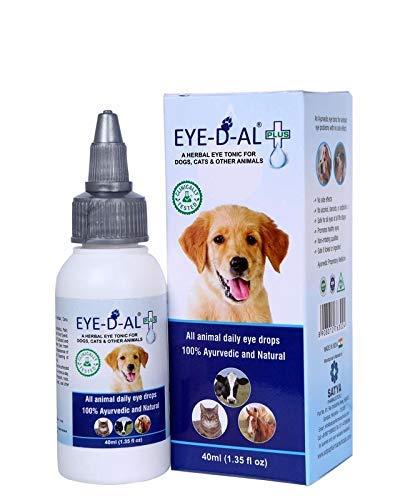Dog Eyedrops: Benefits, Usage, and Safety
Dog owners understand the importance of keeping their furry companions healthy and happy. One often overlooked aspect of canine health is their eyes. Just like humans, dogs can experience various eye problems, from irritation to infections. In this comprehensive guide, we’ll explore the world of dog eyedrops—how they can benefit your pet, how to use them safely, and what you need to know about maintaining your dog’s eye health.
Common Eye Problems in Dogs:
As responsible pet owners, it’s essential to be vigilant about our dogs’ well-being. One way to do this is by being aware of common eye problems that can affect our four-legged friends. Here are some eye issues that dogs frequently encounter:
Conjunctivitis (Pink Eye):
Conjunctivitis, often referred to as “pink eye,” is a common eye condition in dogs. Symptoms include redness, discharge, itching, and inflammation of the eye’s conjunctiva—the thin, transparent tissue that covers the eyeball.
Dry Eye (Keratoconjunctivitis Sicca):
Dry eye occurs when a dog’s eyes don’t produce enough tears to keep the eye moist. This condition can lead to discomfort, redness, and even corneal ulcers if left untreated.

Allergies:
Dogs can be allergic to various environmental factors, including pollen, dust, and certain foods. Allergic reactions often manifest with symptoms such as red, itchy eyes, and excessive tearing.
Understanding Dog Eyedrops:
Now that we’re acquainted with some common eye issues in dogs, let’s explore what dog eyedrops are and how they function.
Dog eyedrops, also known as canine ophthalmic solutions, are specialized liquids formulated to address various eye conditions in dogs. These solutions are typically administered directly into the eyes to provide relief from discomfort, reduce inflammation, and combat infections.
There are different types of dog eye drops available, and their composition can vary based on the specific condition they are designed to treat. Some eyedrops are available over the counter, while others require a prescription from a veterinarian. These solutions work in several ways:
Moisturizing:
Some dog eye drops are designed to provide much-needed moisture to dry eyes, helping to alleviate discomfort and prevent further complications.
Anti-Inflammatory:
Other eyedrops contain anti-inflammatory agents to reduce redness and swelling in the eyes, making them effective for conditions like conjunctivitis.
Antibacterial/Antifungal:
In cases of eye infections, antibacterial or antifungal dog eyedrops are used to combat the underlying cause.
Allergy Relief:
Allergy-related eye issues can be managed with specialized antihistamine or corticosteroid-based eyedrops.
Understanding the different types of dog eyedrops available and their functions is crucial for selecting the right product for your pet’s specific needs. In the next section, we’ll delve into the benefits of using dog eyedrops for your furry companion.
Benefits of Using Dog Eyedrops:
Dog eyedrops offer several benefits for maintaining your pet’s eye health and overall well-being. Here are some key advantages:
Relief from Discomfort:
If your dog is experiencing eye irritation, redness, or itching, eyedrops can provide rapid relief, soothing your pet’s discomfort.
Reducing Inflammation:
Eyedrops with anti-inflammatory properties can help reduce redness and swelling in the eyes, promoting faster healing.
Preventing Infections:
For dogs prone to eye infections, antibacterial or antifungal eyedrops can be essential in preventing the spread of the infection and addressing the root cause.
Allergy Management:
Dogs with allergies can benefit from antihistamine or corticosteroid-based eyedrops, which help control allergic reactions and minimize eye-related symptoms.
Supporting Long-Term Eye Health:
Using dog eyedrops as directed by your veterinarian can help maintain your dog’s eye health, preventing the development of chronic conditions and complications.
Symptoms that May Require Dog Eyedrops:
Recognizing the signs that your dog may benefit from the use of eyedrops is crucial for proactive care. Here are some common symptoms that may indicate your dog needs eyedrops:
Redness:
One of the most noticeable signs is redness in your dog’s eyes. If you observe persistent redness, it’s a signal that something may be amiss.
Itching and Irritation:
Dogs experiencing eye irritation often paw at their eyes or rub their faces against furniture or the floor. This behavior is a clear indicator of discomfort.
Excessive Tearing:
While some tearing is normal, excessive tearing, especially if accompanied by discharge, may suggest an underlying issue.
Squinting or Blinking:
Dogs in pain or discomfort may squint or blink frequently. This can be a sign that their eyes are bothering them.
Watery Eyes:
Persistent watery eyes, not related to emotional factors like excitement, can be a symptom of eye problems.
Discharge:
Unusual discharge from your dog’s eyes, such as pus or mucus, is a clear sign of an issue that may require treatment.
Swelling:
Swelling around the eyes or eyelids is a concerning symptom that warrants prompt attention.
Sensitivity to Light:
Dogs with eye problems may become sensitive to light, often avoiding well-lit areas or squinting in bright sunlight.
Changes in Behavior:
If your dog’s behavior changes suddenly, such as becoming more withdrawn or agitated, it could be due to eye discomfort.
Visible Injury:
Any visible injury to the eye, such as a scratch or foreign object, should be addressed promptly with veterinary care and potentially eyedrops.
If you notice any of these symptoms in your dog, it’s essential to consult your veterinarian for a thorough examination. Based on the diagnosis, your vet may recommend the use of specific dog eyedrops to address the underlying issue.
Choosing the Right Dog Eyedrops:
Selecting the appropriate dog eye drops depends on the specific condition your pet is facing. Here are some factors to consider when choosing the right product:
Diagnosis:
Your veterinarian will diagnose the issue and recommend the most suitable eyedrops. Follow their guidance closely.
Prescription vs. Over-the-Counter:
Some conditions require prescription eyedrops, while others can be managed with over-the-counter options. Always use the product recommended by your vet.
Ingredients:
Check the ingredients list to ensure they are safe for your dog and appropriate for the condition.
Administration:
Consider how comfortable your dog is with the administration method. Some dogs may tolerate liquid drops, while others may need ointment.
Dosage:
Follow your veterinarian’s instructions regarding dosage and administration frequency.
Ensuring your dog’s comfort and well-being is paramount, and using the right dog eyedrops as directed by your vet is a crucial step in that process.
Using Dog Eyedrops Safely:
Administering dog eye drops requires care and precision to ensure your pet’s safety and comfort. Follow these steps to use dog eyedrops safely:
Wash Your Hands:
Begin by washing your hands thoroughly with soap and water. Clean hands help prevent the introduction of contaminants into your dog’s eyes.
Prepare the Area:
Find a well-lit, quiet area where you can comfortably administer the eye drops. Have all necessary supplies within reach.
Restrain Your Dog:
Gently restrain your dog to prevent sudden movements. You may need a second person to assist with holding your dog still if they are resistant.
Administer the Eyedrops:
Hold the eyedropper or bottle with the tip pointed away from your dog’s eye. Carefully pull down the lower eyelid to create a small pocket.
Apply the Drops:
Squeeze the prescribed number of drops into the pocket created by the lower eyelid. Avoid touching the eye or eyelid with the dropper.
Keep the Eye Closed:
After applying the drops, gently hold your dog’s eye closed for a few seconds to allow the medication to spread and be absorbed.
Reward and Comfort:
Praise and reward your dog with a treat or affection after successful administration to create a positive association.
Follow Veterinarian’s Instructions:
Adhere to the dosage and administration schedule provided by your veterinarian. Do not discontinue treatment without consulting them.
More Tips for Administering Dog Eyedrops:
Administering eye drops to your dog may take some practice, especially if your pet is not accustomed to the process. Here are additional tips to help you succeed:
Create a Routine:
Establish a daily routine for administering eyedrops. Consistency can help your dog become more comfortable with the process over time.
FAQs about Dog Eyedrops
Q: Can I use human eye drops for my dog?
A: No, it’s not advisable to use human eye drops for dogs. Dog eyedrops are formulated specifically for canine eye health and should be used under the guidance of a veterinarian.
Q: How do I administer eyedrops to my dog without causing stress?
A: Administering eyedrops to dogs can be made easier with patience and positive reinforcement. Follow our tips for a stress-free process.
Q: Are there any side effects of dog eyedrops?
A: Some dogs may experience mild stinging or irritation upon application. If your dog exhibits severe discomfort, redness, or swelling, contact your vet immediately.
Q: Can I skip a dose of dog eyedrops if my dog seems better?
A: It’s crucial to complete the full course of treatment prescribed by your veterinarian, even if your dog’s symptoms improve. Discontinuing treatment prematurely can lead to a recurrence of the issue.
Q: What should I do if my dog resists eyedrop administration?
A: If your dog consistently resists the process, consult your veterinarian for alternative treatment options or techniques. They may recommend different formulations or suggest strategies to ease administration.
Q: How should I store dog eye drops to maintain their effectiveness?
A: Follow the storage instructions provided on the medication’s packaging. Typically, dog eyedrops should be stored in a cool, dry place away from direct sunlight.
Q: Can I use expired dog eyedrops?
A: It’s best to avoid using expired dog eyedrops, as their effectiveness may have diminished. Check the expiration date on the packaging and dispose of expired products.
Q: What are the signs of an eye infection in dogs that may require treatment with eyedrops?
A: Symptoms of an eye infection in dogs may include redness, swelling, discharge, squinting, and excessive tearing. If you observe these signs, consult your veterinarian.
Q: Are there natural remedies for dog eye problems that can be used instead of eyedrops?
A: While some minor eye issues may respond to natural remedies like saline solution, it’s crucial to consult your vet for a proper diagnosis and treatment plan.
Q: Can dog eye drops be used as a preventive measure, or should they only be used for treatment?
A: Dog eyedrops can be used preventively in some cases, such as for dogs with chronic dry eyes or a history of eye issues. Always consult your vet for guidance on preventive use.
Conclusion:
In this comprehensive guide, we’ve explored the world of dog eyedrops, shedding light on their benefits, safe usage, and the importance of maintaining your dog’s eye health. As responsible pet owners, we must ensure that our furry companions enjoy a life free from discomfort and irritation.




